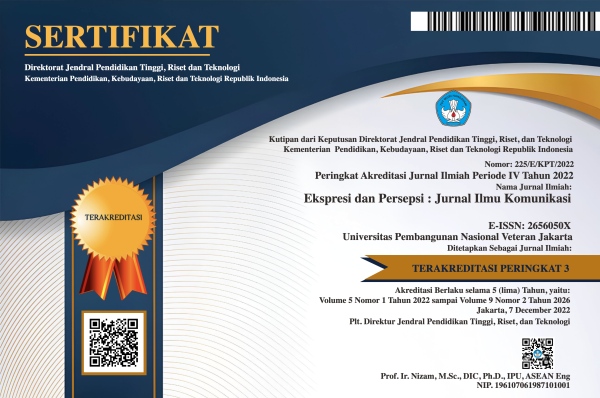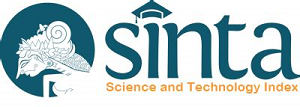Netnographic Research of Netizens' Comments on Mario Dandy's Flexing Actions on the @official iNews YouTube Account
DOI:
https://doi.org/10.33822/jep.v7i3.7513Keywords:
cynicism, flexing, mario dandy, netnography, spiral of cynicism, youtubeAbstract
The surge in social media usage has sparked a trend known as the flexing phenomenon, where individuals, not just celebrities but also regular people, showcase their wealth. This shift was highlighted by a viral YouTube video on the Official iNews channel titled " Mario Dandy Satriyo Anak Pejabat Gemar Pamer Harta di Media Sosial #iNewsSiang 23/02" drawing criticism from viewers. This research employs the netnography method to analyze netizens' reactions to the video. It reveals three main themes in the comments: a cynical perspective on flexing, calls for appropriate consequences for those who flaunt their wealth, and skepticism towards governmental institutions. The predominant sentiments expressed are anger and disappointment, with negative responses prompting demands for government transparency regarding the potential link between flexing and corruption allegations.
References
Anindita, L. (2024). Pengaruh Media Sosial dan Komunikasi Publik Gubernur terhadap Opini Publik (Studi Analisis Regresi Pada Kepemimpinan Gubernur Kepulauan Bangka Belitung Periode 2017-2022). Ekspresi Dan Persepsi: Jurnal Ilmu Komunikasi, 7(1), 71–90. https://doi.org/10.33822/jep.v7i1.7224
Chairilsyah, D. (2019). Strategy to Overcome the Problem of Children Who Like to Show Off. Raudhatul Athfal: Jurnal Pendidikan Islam Anak Usia Dini, 3(2), 99–111. https://doi.org/10.19109/ra.v3i2.4276
Chen, F., Liu, S. Q., & Mattila, A. S. (2020). Bragging and Humblebragging in Online Reviews. Annals of Tourism Research, 80, 102849. https://doi.org/10.1016/j.annals.2019.102849
Chou, H.-T. G., & Edge, N. (2012). “They Are Happier and Having Better Lives than I Am”: The Impact of Using Facebook on Perceptions of Others’ Lives. Cyberpsychology, Behavior, and Social Networking, 15(2), 117–121. https://doi.org/10.1089/cyber.2011.0324
Darmalaksana, W. (2022). Studi Flexing dalam Pandangan Hadis dengan Metode Tematik dan Analisis Etika Media Sosial. The 2nd Conference on Ushuluddin Studies, 8, 412–427.
Defianti, I. (2022). Journal: Fenomena Flexing, Pamer Harta demi Eksistensi. Liputan 6. https://www.liputan6.com/news/read/4928859/journal-fenomena-flexing-pamer-harta- demi-eksistensi
Eisinger, R. M. (2000). Questioning Cynicism. Society, 37(5), 55–60. https://doi.org/10.1007/s12115-000-1038-6
Erber, R., & Lau, R. R. (1990). Political Cynicism Revisited: An Information-Processing Reconciliation of Policy-Based and Incumbency-Based Interpretations of Changes in Trust in Government. American Journal of Political Science, 34(1), 236. https://doi.org/10.2307/2111517
Halpern, D., Katz, J. E., & Carril, C. (2017). The Online Ideal Persona Vs. The Jealousy Effect: Two Explanations of Why Selfies are Associated With Lower-Quality Romantic Relationships. Telematics and Informatics, 34(1), 114–123. https://doi.org/10.1016/j.tele.2016.04.014
Hasibuan, L. (2022). Fenomena Flexing Kekayaan, Tanda Benar-benar Hidup Bahagia? CNBC Indonesia. https://www.cnbcindonesia.com/lifestyle/20220328101257-33- 326465/fenomena-flexing-kekayaan-tanda-benar-benar-hidup-bahagia
Jin, M., Preoţiuc-Pietro, D., Doğruöz, A. S., & Aletras, N. (2022). Automatic Identification and Classification of Bragging in Social Media. ArXiv Preprint. https://doi.org/10.48550/arXiv.2203.05840
Karneva, S. (2021). Celebrities’ Flex Culture - Who Are You Flexing On? Digit Magazine. https://www.diggitmagazine.com/articles/celebrities-flex-culture
Kasali, R. (2022). Inilah Kaya Boong-boongan yang Dipamerkan & Dipercaya Milenial dan Ditiru Luas. Youtube. https://www.youtube.com/watch?v=P8nqLYg8G1Q
Kozinets, R. V. (2002). The Field Behind the Screen: Using Netnography for Marketing Research in Online Communities. Journal of Marketing Research, 39(1), 61–72. https://doi.org/10.1509/jmkr.39.1.61.18935
Kozinets, R. V. (2015). Netnography. Sage Publications.
Lo, I. S., & McKercher, B. (2015). Ideal Image in Process: Online Tourist Photography and Impression Management. Annals of Tourism Research, 52, 104–116. https://doi.org/10.1016/j.annals.2015.02.019
Lyu, S. O. (2016). Travel Selfies on Social Media as Objectified Self-Presentation. Tourism Management, 54, 185–195. https://doi.org/10.1016/j.tourman.2015.11.001
Marder, B., Archer-Brown, C., Colliander, J., & Lambert, A. (2019). Vacation Posts on Facebook: A Model for Incidental Vicarious Travel Consumption. Journal of Travel Research, 58(6), 1014–1033. https://doi.org/10.1177/0047287518786465
Michikyan, M., Dennis, J., & Subrahmanyam, K. (2015). Can You Guess Who I Am? Real, Ideal, and False Self-Presentation on Facebook Among Emerging Adults. Emerging Adulthood, 3(1), 55–64. https://doi.org/10.1177/2167696814532442
Naning, S., Haloho, H. N. Y., & Agustia, E. (2021). Pengaruh Pesan Nonverbal Buzzer di Media Sosial Terhadap Minat Beli. Ekspresi Dan Persepsi: Jurnal Ilmu Komunikasi, 4(2), 114–126. https://doi.org/10.33822/jep.v4i2.2552
Ren, W., & Guo, Y. (2020). Self-praise on Chinese social networking sites. Journal of Pragmatics, 169, 179–189. https://doi.org/10.1016/j.pragma.2020.09.009
Schenck-Hamlin, W., Procter, D., & Rumsey, D. (2000). The Influence of Negative Advertising Frames on Political Cynicism and Politician Accountability. Human Communication Research, 26(1), 53–74. https://doi.org/10.1111/j.1468-2958.2000.tb00749.x
Valentino, N. A., Beckmann, M. N., & Buhr, T. A. (2001). A Spiral of Cynicism for Some: The Contingent Effects of Campaign News Frames on Participation and Confidence in Government. Political Communication, 18(4), 347–367. https://doi.org/10.1080/10584600152647083
Veblen, T. (1899). The Barbarian Status of Women. American Journal of Sociology, 4(4), 503– 514.
Wattenhofer, M., Wattenhofer, R., & Zhu, Z. (2021). The YouTube Social Network. Proceedings of the International AAAI Conference on Web and Social Media, 6(1), 354–361. https://doi.org/10.1609/icwsm.v6i1.14243
Xiang, Z., & Gretzel, U. (2010). Role of Social Media in Online Travel Information Search. Tourism Management, 31(2), 179–188. https://doi.org/10.1016/j.tourman.2009.02.016
Downloads
Published
Issue
Section
License
Copyright (c) 2024 ni wayan suryatini

This work is licensed under a Creative Commons Attribution-NonCommercial 4.0 International License.














